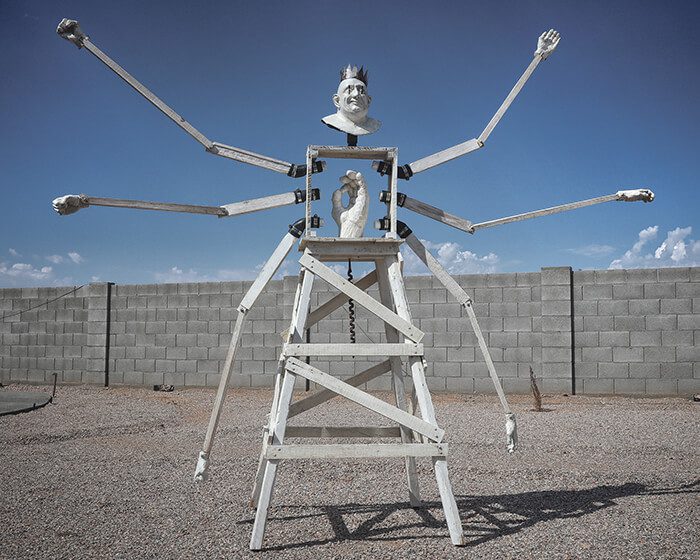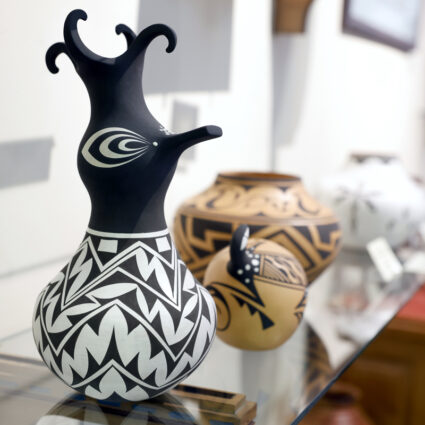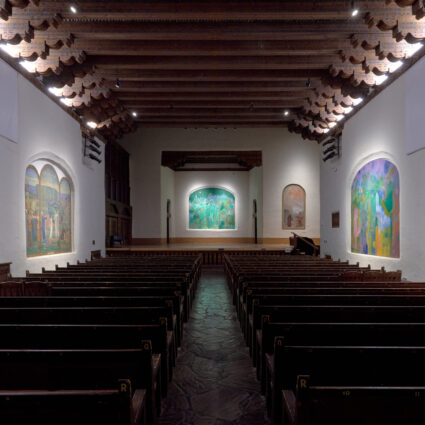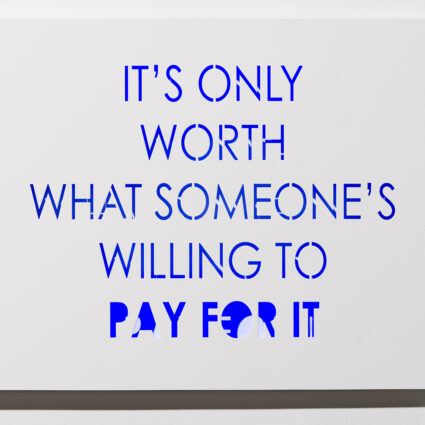
Martin Spei, Latent Fuss, 2017, wood and mixed-media sculpture, 84 x 84 x 28 in.
Blue Rain Gallery, Santa Fe
October 13 – 27, 2017
In his exhibition title, the artist Martin Spei introduces his viewers to the concept of tramoya, defining the Spanish term as “various leftover stage props and devices that may or may not be seen as detritus by the next play’s crew when they build their new set.” Translated into English, Google suggests “trick or swindle,” as well as the more theater-specific term, “piece of stage machinery.” For his show of eight interactive mixed-media sculptures plus several figurative drawings at Blue Rain Gallery this October, Spei refers to the leftover devices and machinations “behind a theater of power.” Our would-be or have-been kings, says Spei, “rule over subjects they can only vaguely remember and perpetuate their comical maneuvering of a traditional and absurd power system.” Spei elaborates on the comedic aspect of his subjects by making them out of found materials, their spindly legs and arms barely defined and as tenuous as a puppet’s; in fact, most of the sculptures in his show actually function as marionettes. One of the pieces (King Koin), which I think of as “Dr. No,” can only shake his head when you add money to his piggy-bank: “No, I will not use your money on projects that might make your community better. I will keep it here with me. In fact, I’m pretty sure I can take it with me, and I’m sure as hell going to try.”
Timing and context are everything. Because I saw this series of artworks at about the one-year anniversary point of what I consider to be a tragically disastrous presidency, I immediately associated Spei’s figures, clown-like and obese with their gluttony for self-satisfaction, with the current administration. As such, I thought the sculptures and drawings were not only technically very well made—inarguable in Spei’s case; he is a skilled bronze artist whose experience is evident and translates quite nicely to the mixed media he used in the Tramoya series—and pleasing to look at, but that they seemed to be accurate statements about circumstances in today’s U.S. of A. In other words, they fitted neatly into my own perception of what our political system looks like: a morbidly unfit cadre of wealthy white men chasing after the last vestiges of a failing vision of success. Had I viewed Tramoya Royale during President Obama’s terms of office, I’m sure I wouldn’t have had any problem with assigning these characters with the names of various rich men for whom institutionalized racism, and even white supremacy, work just fine.
The point is that Spei’s round-as-the-Buddha men in suits, whether they’re his finely cast bronze figures or the rougher Tramoya, are all too clearly the “bad guys.” While the work is assured in its fine craftsmanship and the artist in his aesthetic choices, I wonder if the sense of superiority they gave me (because my political views are so much more, you know, advanced) comes way too easily and at the cost of the black-and-white thinking that leads to the universal problem of “us vs. them.” After all, though they may not look like Spei’s guys, there are plenty of men and women who spend money on the arts here in Santa Fe whose fortunes come from business practices with questionable ethics. It’s a story as old as the Industrial Age’s Carnegies and Guggenheims, as old as the Egyptian pharaohs and medieval kings and queens. Really, this line of philosophizing leads me to conclude that the very business of being human is loaded with opportunities to hurt others. Does pointing fingers help? This is where timing and context enter in. Ask any victims of the Holocaust and the answer is an obvious affirmative. When it comes to the business of art, assigning blame is as blurry as a Gerhard Richter squeegee painting. And when it comes to making art, I can’t speak because I don’t have the necessary skills, talents, and patience to create objects. When it comes to looking at art, all I can offer is my opinion, which is wildly mitigated by my own experiences. Twenty years ago, before I studied art history and theory, I would have adored Martin Spei’s work. Now, I’m looking for something a little less literal. Nonetheless, I remain convinced that I saw an exhibition by an artist who is well worth watching as his content develops and grows. He’s got the media down; let’s see where they take him next.



